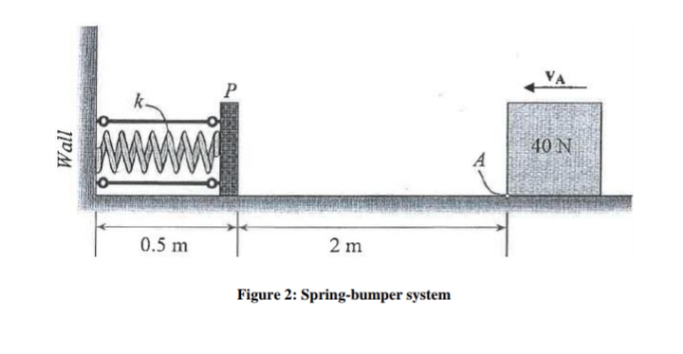The spring bumper is used to arrest the motion of the 40 N block, which is sliding towards it at VA = 3 m/s. As shown in Figure 2, the spring is confined by the plate P and the wall using cables so that its length is set to 0.5 m. If the stiffness of the spring is 1500 N/m, determine the required unstretched length of the spring so that the plate is not displaced more than 0.1 m after the block collides on it. Neglect friction, mass of the plate and spring and the energy loss between the plate and the block during collision.
The spring bumper is used to arrest the motion of the 40 N block, which is sliding towards it at VA = 3 m/s. As shown in Figure 2, the spring is confined by the plate P and the wall using cables so that its length is set to 0.5 m. If the stiffness of the spring is 1500 N/m, determine the required unstretched length of the spring so that the plate is not displaced more than 0.1 m after the block collides on it. Neglect friction, mass of the plate and spring and the energy loss between the plate and the block during collision.
Related questions
Question

Transcribed Image Text:The spring bumper is used to arrest the motion of the 40 N block, which is sliding towards it at
VA = 3 m/s. As shown in Figure 2, the spring is confined by the plate P and the wall using
cables so that its length is set to 0.5 m.
If the stiffness of the spring is 1500 N/m, determine the required unstretched length of the
spring so that the plate is not displaced more than 0.1 m after the block collides on it.
Neglect friction, mass of the plate and spring and the energy loss between the plate and the
block during collision.

Transcribed Image Text:P
40 N
www
0.5 m
2 m
Figure 2: Spring-bumper system
Wall
Expert Solution
This question has been solved!
Explore an expertly crafted, step-by-step solution for a thorough understanding of key concepts.
This is a popular solution!
Trending now
This is a popular solution!
Step by step
Solved in 2 steps with 1 images
